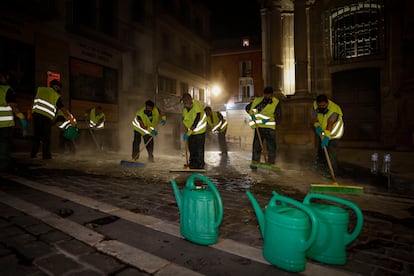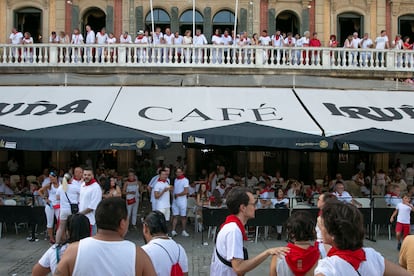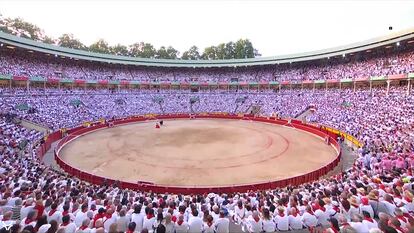Eight bull runs, 16 ambulances, and 2,500 runners a day on an 800-meter route: the Sanfermines return from July 6 to 14.

The most impressive-looking and brazenly horned bulls rest in the Corrales del Gas (Gas Corrals); the red and white uniforms await, immaculate and ironed; the train and bus stations are a constant hive of visitors; hoteliers rub their hands at the sky-high occupancy; bars and restaurants stock up on food and drinks and prepare for days of exhausting work. The center of Pamplona is a row of wooden planks and posts; the gleaming bullring awaits the start of the festival, and nerves are on edge, as if the footsteps of oxen and bulls could be heard in the distance on the morning of the first running of the bulls.
This is the appearance of the city of Pamplona, the hallmark of the 2025 San Fermín Fair , the most international popular and bullfighting festival, which brings together thousands of people from all over the world.
The Navarrese capital has been experiencing a special hustle and bustle for days. For many days, because on June 2nd, the assembly of the bull run fence began, a conglomeration of 900 posts, 2,700 planks, 2,500 wedges, and eight gates that mark out and close off an 848.6-meter route that begins at Cuesta de Santo Domingo and ends at the bullring. There, every morning from July 7th to 14th, the bulls that will be fought that afternoon run among a crowd of young men and women who have fun and risk their lives amid sharp horns, falls, and wild runs.
But before that, at 12 noon this Sunday, three representatives of Yala Nafarroa con Palestina (Yala Nafarroa with Palestine), a platform that brings together 225 groups and more than 1,700 people, will launch the chupinazo (firecracker) from the balcony of City Hall, kicking off the festivities. And the sound of that first rocket will be heard far beyond a square packed with Pamplona residents dressed in white and red, celebrating the start of the festivities in the colorful San Fermin uniform, splashed with calimocho (a type of firecracker) and the sweat of a fervent crowd. And so it will go, 24 hours a day, until the evening of July 14th, when "el pobre de mí" (poor man of me) is sung, bidding farewell to the San Fermin festival of 2025.
Lack of symbolsNine days remain, with music, dancing, and even alcohol taking over the city streets, filled with hundreds of activities organized by the City Council so that everyone in attendance, of all ages, has nothing to worry about but enjoying themselves. But alongside the municipal offerings, the true and most prominent identity of these festivities lies in the figure of San Fermín, the bull, the morning bull runs, and the bullfighting festivities—the very stars that the Navarrese council, governed by Bildu, has decided to hide in a promotional video for the festivities.
For one minute and 25 seconds, images of the giants and big-heads and the bustle of the streets are interspersed with brief interventions by 11 people—seven women and four men—who emphasize that San Fermín is “a time of encounters,” “a festival full of flavors,” “the festival of a people that we have known how to share with the rest of the world,” “it is seeing life in red and white again”…, but no trace of the saint, nor of the running of the bulls, nor of the bulls.
Despite this, preparations continue, and everyone, local and foreign, is already thinking about getting up early to experience the excitement of the race up close or feel the tension from a balcony or TV screen. The chupinazo (firecracker) hasn't even been launched yet, but it's already terrifying to walk along Cuesta de Santo Domingo, the Town Hall Square, Mercaderes and Estafeta streets, the Telefónica section, and the Callejón area, the exclusive territory of the bull for the three minutes or so that it takes to make the long, fast, and hectic journey to the ring of the six chosen for the fight and the daily company of the oxen. And along with the animals, there are an average of 2,500 runners daily (4,000 on weekends), of which only 6% are women.
The bulls that will be fought in the first four bullfights of the fair have been resting since this Wednesday in the Corrales del Gas, and can now be visited for four euros for adults and free for accompanied minors. From there, the night before their fight in the bullring, they are moved silently and without the presence of onlookers to the Corrales de Santo Domingo, a distance of 400 meters, where they will rest until 8 a.m. when they are awakened by the rocket that announces the start of the race.

On the streets, nerves were on edge, and some basic rules must be followed to protect the physical safety of the participants. The fence closes at 7:30, and by that time, law enforcement officers have already evacuated minors and anyone showing signs of having consumed alcohol or drugs. Objects that could hinder the race, such as backpacks or cameras, are not permitted; touching or disturbing the bulls is prohibited, and in case of a fall, it is advisable not to get up and to protect your head.
Despite the frequent occurrence of bruises, fractures, and the occasional goring, Navarrese health authorities have established a team of nine stations at the foot of the fence, eight support points staffed by lifeguards, and the bullring's infirmary. In total, more than 100 professionals, including doctors, nurses, lifeguards, technicians, and workers, will be equipped with 16 medical ambulances distributed throughout the route.
And to contribute to safety, on Tuesday night, the 1st, workers from the company contracted by the City Council applied, as has been done since 2005, 1,500 liters of anti-slip liquid in different areas of the running of the bulls to prevent the bulls from falling and the fragmentation of the herd, "which increases the speed of the race and, ultimately, minimizes its danger," according to the council itself.
Hotels, 500 euros a nightMeanwhile, hotels welcome guests at prices ranging from €500 to €1,000 per night, which does not prevent the Pamplona Hotel Association from estimating an average occupancy rate of 83.4%, higher than that recorded in 2024, and 90% on the days of peak demand, from July 6 to 9.

For its part, the City Council has published a leaflet containing the well-known San Fermin decalogue (15,000 copies in Spanish, Basque, English, and French), with basic recommendations "for a safe and civil festival." It also emphasizes that Pamplona is a city that is inflexible in the face of sexist attacks and urges people to report them.
To ensure everything runs as smoothly as desired, more than 2,700 officers from the National Police, Civil Guard, Regional Police, and the capital's Municipal Police will be part of the operation planned for this year's San Fermin festival. Six drones will fly during key moments of the festivities (chupinazo, bull runs, bullfights, and fireworks), and a helicopter will be operational every day.
And, in the afternoon, the San Fermin festival focuses on the bullring: eight bullfights, a bullfighting show, and a bullfighting bullfight make up the so-called Bull Fair, organized by the Casa de Misericordia, which runs a senior citizen's home and whose maintenance is funded by the profits from the festival. This year's budget amounts to €4.7 million, 4 percent more than in 2024, and the price of season tickets to attend the bullfights has increased by 2.5 percent, which will not prevent the Pamplona bullring from being packed every afternoon.

For the first time in the history of Pamplona's bullring, a woman, the French rejoneadora Lea Vicens , is announced on the posters and will be performing on Sunday the 6th. Along with her, the other star will be the Peruvian bullfighter Roca Rey, the only bullfighter who will perform on both evenings.
Saturday, July 5. Bullfight. Aaron Palacio, El Mene, and Bruno Martínez (bulls from Pincha).
Sunday, 6th. Bullfighting show. Roberto Armendáriz, Lea Vicens, and Guillermo Hermoso de Mendoza (bulls from El Capea).
Monday, 7th. Miguel Ángel Perera, Alejandro Talavante and Daniel Luque (bulls from Fuente Ymbro).
Tuesday, 8th. Antonio Ferrera, Roman and Victor Hernandez (bulls from Cebada Gago).
Wednesday, 9th. Morante de la Puebla, Roca Rey and Tomás Rufo (bulls from Álvaro Núñez).
Thursday, 10th. Sebastian Castella, Emilio de Justo and Borja Jimenez (bulls from Victoriano del Rio).
Friday, 11th. Juan Ortega, Roca Rey and Pablo Aguado (bulls from Jandilla).
Saturday, 12th. Rafaelillo, Fernando Robleño and Juan de Castilla (bulls from José Escolar).
Sunday, 13th. Jiménez Fortes, Fernando Adrián and Ginés Marín (bulls from La Palmosilla).
Monday, 14th. Manuel Escribano, Damian Castano and Jesus Enrique Colombo (Miura bulls).
EL PAÍS





